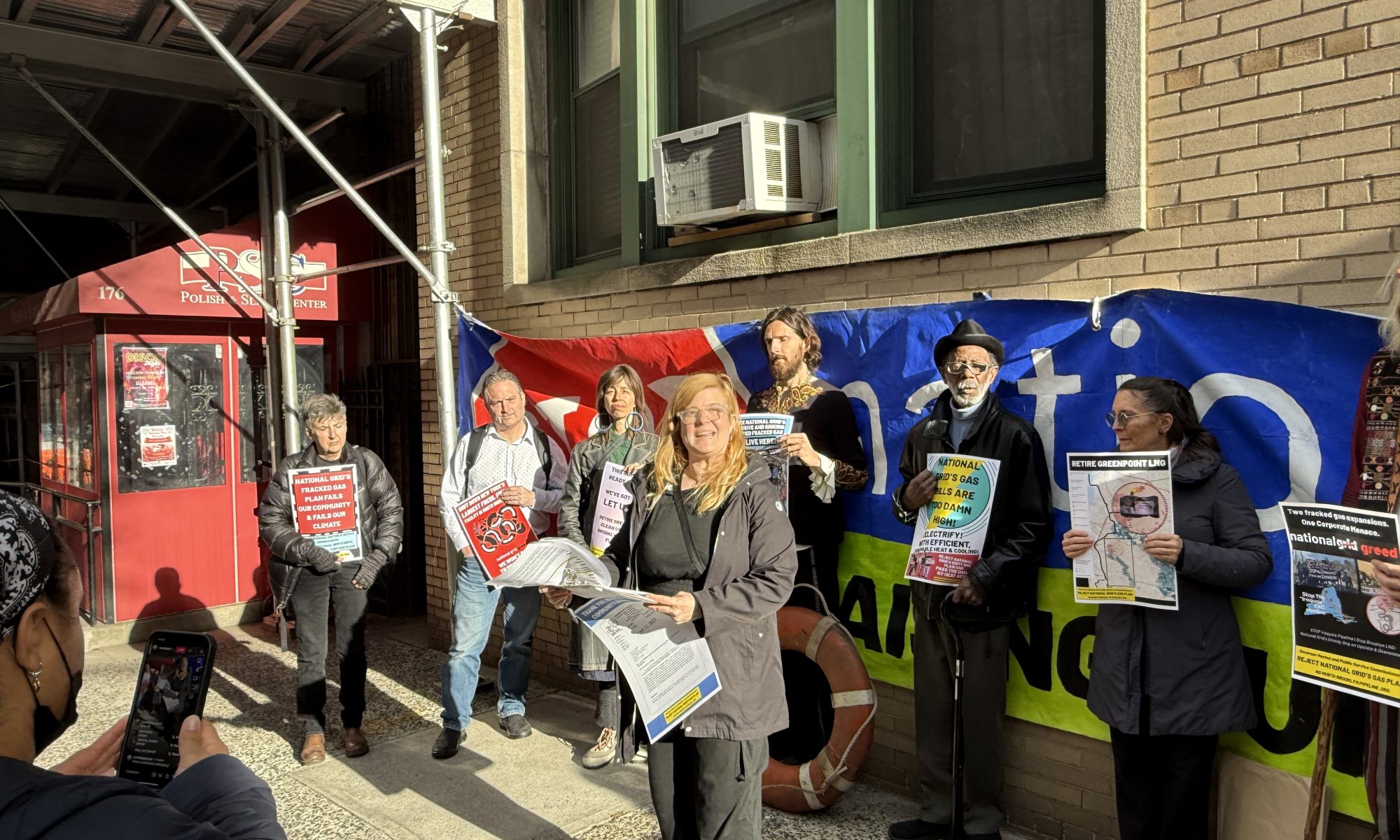BY JACK DELANEY | jdelaney@queensledger.com
To a passerby strolling down the sunny sidewalk, it might have seemed improbable: the main obstacle preventing one of the largest gas providers in New York from receiving billions to expand its fossil fuel infrastructure across the state was this small crowd on Java St, hell-bent on being heard, and two bearded twins in pirate costumes.
For the past decade, a local nonprofit called Sane Energy Project has campaigned to decommission the nearby Greenpoint Energy Center, a natural gas depot — at 117 acres, the largest in the state — on the waterfront of Newtown Creek. The facility is owned by National Grid, the British energy behemoth responsible for servicing over 20 million people in New York and Massachusetts, which has repeatedly sought approval from the state regulator to upgrade the site’s two tanks. But in part due to community backlash, most of those requests have been denied. (Last August, the state did eventually allow a $271 million overhaul of the center, financed by rate hikes for gas customers.)
The stakes are greater this time. National Grid is asking the state to approve a long-term plan that would not only expand the Greenpoint Energy Center, but also entrench the use of hydrogen and natural gas throughout New York by building miles of new pipelines. The most conservative scenario in the plan calls for $60 billion, much of which would be passed off to consumers as higher gas rates. Over 1,800 members of the public have submitted comments, opposing the proposal by an overwhelming margin. And after a year of tense hearings and legal back-and-forth within the Public Service Commission (PSC), the state agency in charge of regulating utilities, a verdict is nigh.
This was the last push. The roughly 40 people gathered on Wednesday outside the Polish and Slavic Center on Java St — an assortment of concerned neighbors, environmental activists from groups like Sane Energy, Newtown Creek Alliance, and 350 Brooklyn, and staffers for local politicians — had come for the penultimate hearing of the public comment period. But they were intent on doing it their own way: the regulator had denied their demand to have an in-person meeting, so they had decided to hold a “People’s Hearing,” logging into the virtual platform as a united front with the name “North Brooklyn Community.” (“If we were online,” an organizer asked, “would we be able to feel the power of the people as we are right now?”)

That was the plan, at least. After a series of brief speeches just off Manhattan Ave, the throng filed into the building for the hearing. Greenpointers of all ages filled an unused classroom to the brim; in the back, two supporters perched on a piano bench. The mood was boisterous as the proceeding began and a PSC functionary read out the rules. When it came time to testify, however, pandemonium set in.
“Steff McGraw? If you are a call-in user, please press star-three so I can identify you,” said an administrator, deaf to the chaotic shouts in Brooklyn. She paused briefly before moving on. “The next registered speaker is Michael Davis. If you are a call-in user…”
It quickly became clear that the “North Brooklyn Community” would not be able to speak — its mic was muted, and officials were not responding to requests to enable video. The residents scrambled to call in as the PSC facilitator marched briskly through the list, crossing names off as no-shows.
Finally, Greenpoint City Councilman Lincoln Restler asked to jump the online queue. Restler first expressed his opposition to National Grid’s designs for the Greenpoint Energy Center, arguing that “any long-term plan that does not propose working towards retiring this facility is not a long-term plan that needs to be in our community.”
“Now is the time to put all of our energy and all of our resources into renewable energy, not infrastructure that will soon be obsolete,” he said. “This plan is frankly irresponsible.”
Then Restler addressed the elephant in the room. “Before I wrap, I want to say that I’m getting a series of text messages. There are 40 people called ‘North Brooklyn Community’ on the WebEx, and they’re not permitted to call in. They’re eager to speak and contribute and share their expertise—”
“If there’s time at the end of the hearing, we’ll call people who haven’t registered,” interjected Hon. Anthony Belsito, the presiding judge, cutting him off brusquely.
Kim Fraczek, founder of Sane Energy, claimed that the PSC had in recent months made it more difficult for community members to access crucial context about the plan. In early April, Fraczek’s group filed a motion asking the regulator to “withdraw its sudden, arbitrary, and capricious decision to prohibit further information sharing” between the nonprofit and an independent monitor, PA Consulting, which the state hired to verify the assertions in National Grid’s long-term plan. “After months of open communication among National Grid, Sane and other stakeholders, and Staff as well as its consultant, PA Consulting, Staff abruptly cut off information sharing at a critical part of the proceeding — one week before comments were due for National Grid’s consideration.”
But Restler pressed Belsito, and eventually, after sorting through a few technical hiccups, the judge relented. The floor was open.
Like all of New York’s utilities, National Grid does not make its profits from selling gas to customers. In return for the monopoly the company is granted by the state, it instead must ask the regulator to raise rates — and justify those hikes with expenses like capital investments, such as building pipelines or upgrading the Greenpoint Energy Center.
The relationship between the utility and the state can be contentious. In 2019, the PSC denied National Grid’s proposal for a $1 billion, 37-mile pipeline; in retaliation, the company refused to activate gas hookups for both new and returning customers, turning down over 3,000 requests and leaving developers, landlords, and tenants in limbo, unable to connect to the gas supply with winter fast approaching.

Yet the state struck back. Then-Governor Andrew Cuomo gave National Grid an ultimatum: either lift the moratorium on hook-ups, or have their license to operate in downstate New York revoked.
That the hearing on Wednesday happened at all is a consequence of that battle. Facing Cuomo’s threat, National Grid backed down, but the state wanted to ensure that such a hostage-taking situation wouldn’t occur again. In 2022, the PSC required that gas utilities publish long-term plans on a three-year cycle, outlining the steps they would be taking to follow New York’s landmark 2019 climate law, the CLCPA, which mandates decarbonization.
In the plan currently up for consideration, National Grid writes that it supports “a strategic transition away from fossil natural gas.” However, it argues that the shift to renewables should not “impose undue cost burdens on customers who currently rely on this fuel for home heating,” and its $60 billion proposal involves “ongoing maintenance of the gas network and near-term investments in strategic assets to maintain the gas network.”
From their base in the Polish and Slavic Center, residents and politicians alike made clear that they weren’t buying that logic.
The aforementioned Steff McGraw, chief of staff for state Assemblywoman Claire Valdez, highlighted the economic ramifications of the plan.
“Many of the constituents I serve struggle financially,” she declared, “surviving on low wage jobs while grocery prices skyrocket and the real estate industry preys on our neighborhoods, jacking up rents. One of the most persistent problems we face is the annual increase in rates from investor-owned utilities. You, the Public Service Commission and the Department of Public Service, have the power and obligation to protect New Yorkers from these steadily rising bills.”
“[National Grid] is financially motivated to continually increase the reach and lifetime of the gas system,” read McGraw, “not because it is needed, but because it makes investors and executives rich. There are other and better ways than gas to meet the need for heat — implementing these would not only eliminate the need for the Greenpoint Energy Center and expanded gas capacity, but also improve health and safety. With a climate denier in the White House, state governments must move with extreme urgency to phase out fossil fuels now. I urge the PSC to see this proposal for what it is — a reckless cash grab that will lock working families into a cycle of higher energy bills and climate chaos — and reject it.”
Sara Gronim testified on behalf of the 4,500 members of the environmental group 350 Brooklyn, picking up McGraw’s thread. “Many people have given you all the reasons you’re familiar with,” she said. “I’m going to give you another one: the cost to replace gas lines in the city is something like $6 million a mile. Expansion of service, such as what National Grid proposes, is also phenomenally expensive. All of this is billed to us, the customers.”
“It’s wasteful, and it delays essential action,” Gronim added. “As everyone has said, we need investment in 21st century solutions: thermal energy networks, recycling, wasted energy efficiency, and electrification.”
Along with finances, the community voiced concerns about the health implications of allocating more funds to natural gas infrastructure.
“I’m speaking on behalf of all the sick people,” said Vincent Vespole, who has lived in the neighborhood for 60 years. “People don’t know what those white tanks are, but my father grew up in Greenpoint on Beadel St, right next to the facility, and he died from cancer. My mother grew up in Greenpoint, she died from cancer. My brother died from cancer. And now I’m being treated for cancer.”
“It’s deadly serious,” Vespole stressed. “What we need is renewable, safe energy there, and we need our Little League back, which was closed because the soil was too toxic.”

In a statement, a spokesperson for National Grid said that “the Long-Term Plan demonstrates that the natural gas network is essential for meeting our customers’ energy needs, especially on the coldest days when customers’ gas demand peaks. The plan also outlines our vision for the future of gas in New York and identifies the policies and investments necessary to put New York on track to achieve the CLCPA’s emissions goals.” He further noted that “ongoing and planned operations at the Greenpoint Energy Center will not impact environmental remediation efforts in the area.”
But state Senator Kristen Gonzalez echoed Vespole’s calls for the Greenpoint Energy Center to be retired, and for the site to be remediated. “I stand with my constituents in opposing National Grid’s long term plan,” she said via a representative. “My waterfront district, which is increasingly vulnerable to flooding due to climate change, can’t wait until 2050 for National Grid to make good on their commitment to transition to clean energy. [The company] says they’re fully committed to our CLCPA goals, but this plan says quite the opposite.”
Earlier this month, New York City also called upon the PSC to require that National Grid revise its long-term plan. In its formal comments, lawyers for the city noted that the company’s choice of the “Clean Energy Vision” — the more fossil-fuel-intensive course of action, compared to “Advanced Electrification” — relies on “unreasonable assumptions regarding the availability of renewable natural gas and the expected usage of hydrogen.”
Many of those who testified voiced support for the long-stalled NY HEAT Act, which would cap energy bills at 6% of household income and shift subsidies from gas projects to fund renewable energy upgrades for low and middle-income New Yorkers.
After three hours, a weary Belsito cued in the last caller, who introduced himself as Cory. His earnest intro was a fake-out: thirty seconds in, he launched into a rowdy, “ahoy matey” parable about a lighthouse. The bottom line, buried ten leagues down in the metaphorical ocean deep, was that National Grid’s plan should be rejected.
“I liked that accent,” an administrator said in the background, as the screen went dark.
The independent consultant is set to file its final report on May 9, and the PSC’s deliberations will take place this fall. You can follow the proceeding as it develops here, and can read the long-term plan here.


















